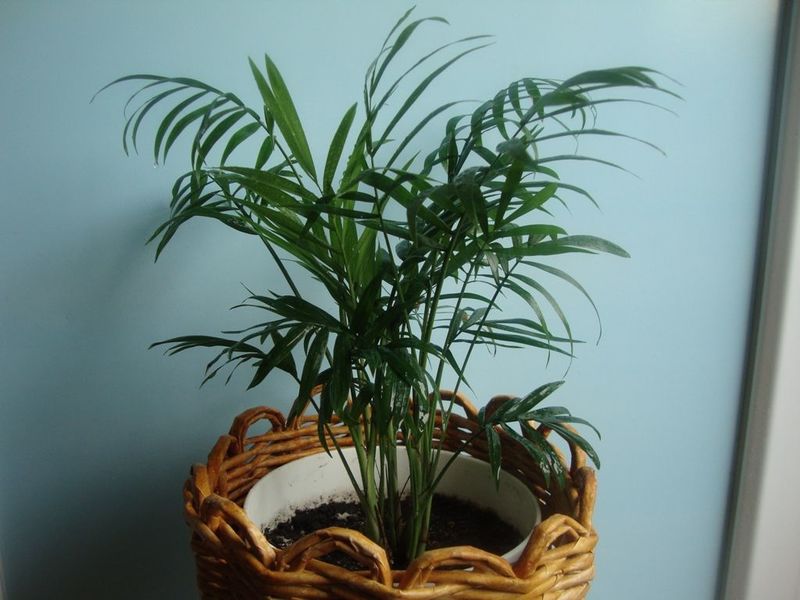Tsikas (cycad, sago palm) is an ancient plant from the Sagovnikov family. Due to their unpretentiousness, representatives of this genus continue to exist in our time. Many novice growers are afraid to start a flower, because there are many rumors about its capricious nature. Indeed, it is difficult to take care of him at home, but if all the conditions and rules are observed, a good result can be achieved.
Content
Is it difficult to grow cicas at home
In nature, the plant has a powerful trunk up to 80 cm in diameter, and the height reaches 7 m. The leaves grow very slowly - only 1-2 plates per year.
Caring for a cicada at home is difficult. The sago tree grows extremely slowly, in closed rooms it usually reaches a height of 50-80 cm. Its life cycle is very long, so the cycad even lives in apartments for a very long time.
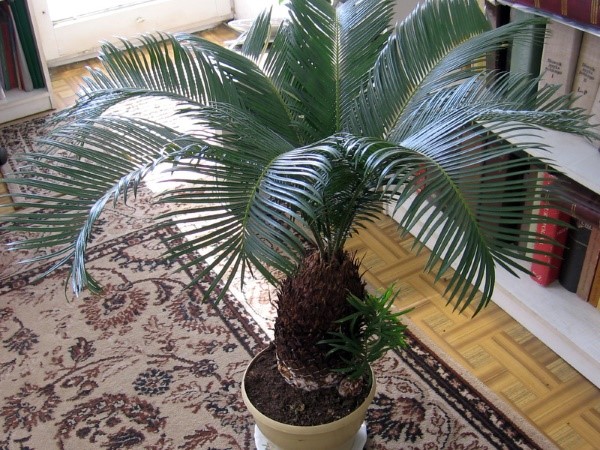
Cycas contains toxins, so growers who have children and pets are advised to keep the flower away from them, or not at all. When an animal comes into contact with a plant, poisoning occurs, as a result of which the pet may even die.
You also need to remember about its cost - the cicas flower belongs to expensive plants. Its cost in adulthood reaches several thousand rubles.
Varieties with photos
There are about 90 sago palm species on the planet, but only a few are suitable for home keeping. Each of the varieties has its own characteristics.
Tsikas Revolution

At home, the cicas of revolution is actively cultivated. This is due to its dimensions (maximum height 1.8 m), which are optimal for an apartment or house. The leaves are large, dark green with a glossy surface.
Cochlea cicas
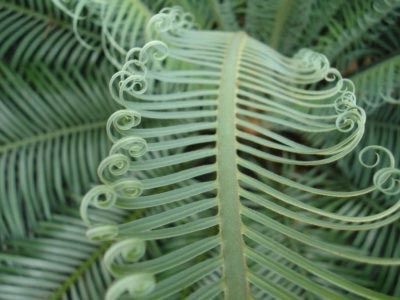
It is also called curled or feathery. The leaves are large (over 1 m in length) and are divided into 100-200 lobes. They resemble a dove feather in shape.
Tsikas Rumfa
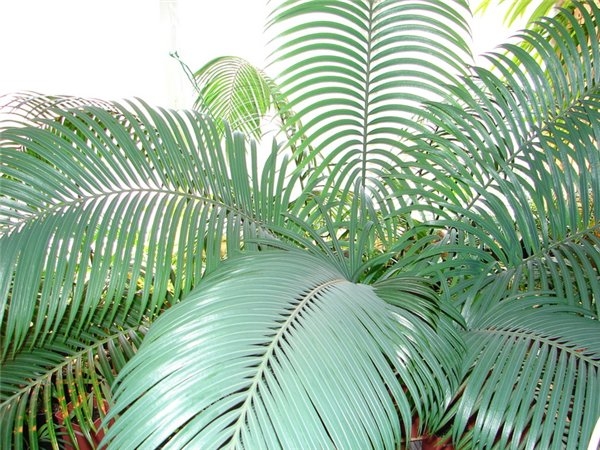
Rumfa has curved emerald leaves, which are still versatile - glossy in front and matte in back. It is the fastest growing species.
Siamese cicas

A low flower (an adult plant is not more than 170 cm). The leaves are bluish-white in color, reaching a length of 1 m. The leaf stalks are covered with thorns.
Optimal conditions: table
The conditions for keeping a sago tree depend on the season. The optimal parameters of lighting, humidity and temperature are described in the table:
| Season | Lighting | Temperature | Humidity |
| Spring Summer | Requires bright sunlight. It is advisable to put the flower on the windowsill from the southeast or southwest | The optimal value is an air temperature of 20-23 degrees, although the plant will easily tolerate higher rates. In summer, it is allowed to take the flower out to the balcony or veranda. But you must watch out for the absence of drafts.It is recommended to create an artificial shadow for him at noon. | At temperatures above 20 degrees, the air humidity should be at least 60%. For this, it is recommended to use a special humidifier or a container of water, which is located near the flower. It is recommended to periodically spray the palm tree with water and wipe the leaves with a damp cloth |
| Autumn winter | Place the flower on the south side and use artificial lighting with lamps for at least 12 hours a day. Due to the lack of light, the plant stops growing, and the leaves begin to turn yellow and lengthen. | Optimal values are 15-17 degrees. The flower is sensitive to lower temperatures and sudden changes. But the high air temperature will lead to the fact that the plant will begin to fall out of leaves. | While maintaining the desired temperature, air humidity does not matter |
When and how to replant
A newly purchased plant cannot be transplanted immediately, since the cicassa needs to get used to the new conditions (at least 2 weeks). It should be borne in mind that the transplant is allowed to be performed only in spring (late February-early March).
Transplanting during this period will be prohibited if the cicassus releases new leaves.
If the plant is less than 5 years old, then it is recommended to replant it annually. Upon reaching 5 years of age - once every 4-6 years. But every year, continue to renew the top layer of the earth by 1/3.
It is also important to choose the right pot. It should be ceramic and its diameter is only 2-3 cm from the previous one. It is not recommended to take a very large pot, since the ground that is not occupied by roots will begin to sour.
Tsikas loves light and breathable soil. This can be a ready-made composition for palm trees or a self-prepared mixture. For her you will need:
- 2 pieces of sand;
- 2 parts crushed nutshells;
- 1 part of sod land;
- 1 part of humus;
- 1 part sphagnum;
- 1 part of brick chips;
- a handful of bone meal.
Shells, sand and brick chips are drainage. It is recommended not to lay them on the bottom, but to distribute them evenly throughout the pot.
The transplant process consists of several stages:
- Wash and dry the new pot.
- If a ready-made mixture is used, then drainage (washed large pebbles) 3-4 cm is poured onto the bottom, and a little soil on top.
- If the soil was prepared on its own, then it should be poured a little on the bottom.
- Cut off 1/3 of the lower old leaves before planting.
- Sprinkle the cut sites with activated carbon.
- Carefully pull the flower out of the old pot, without breaking the earthy clod and roots.
- Place the flower in a new pot, add soil around the edges and tamp it.
It is not recommended to water the cicas immediately after transplanting. A day later, it is allowed to water it with a small amount of settled water.
Watering rules
Proper watering and regular spraying of the plant is the key to its health. Most often, a violation of the following rules leads to a poor plant condition:
- If the air humidity is observed, the flower must be watered in summer 1 time in 5 days, and in winter - 1 time in 14 days. But it is recommended to focus on the condition of the soil. The optimal time is considered when the ground to the bottom of the pot is dry. If the soil has already begun to move away from the walls, then the plant does not have enough water.
- You cannot water the stem.
- For irrigation, only water that has been settled during the day is used.
- After 15-20 minutes after watering, the water from the pan should be poured out.
- In the summer, you need to spray the cicas once a day. In winter, if the temperature is high and the humidity is insufficient, then 2 times a day.
Top dressing
In the spring and summer, the cicassus needs feeding every 2 weeks. In autumn - once a month, but the dose should be divided by 2. In winter, during the period of illness, at low temperatures and immediately after transplanting, no feeding is performed for a month.
As a fertilizer, you can use a ready-made composition, which is intended for palm trees or decorative deciduous houseplants (for example, cacti). Moreover, they should not contain magnesium and calcium.
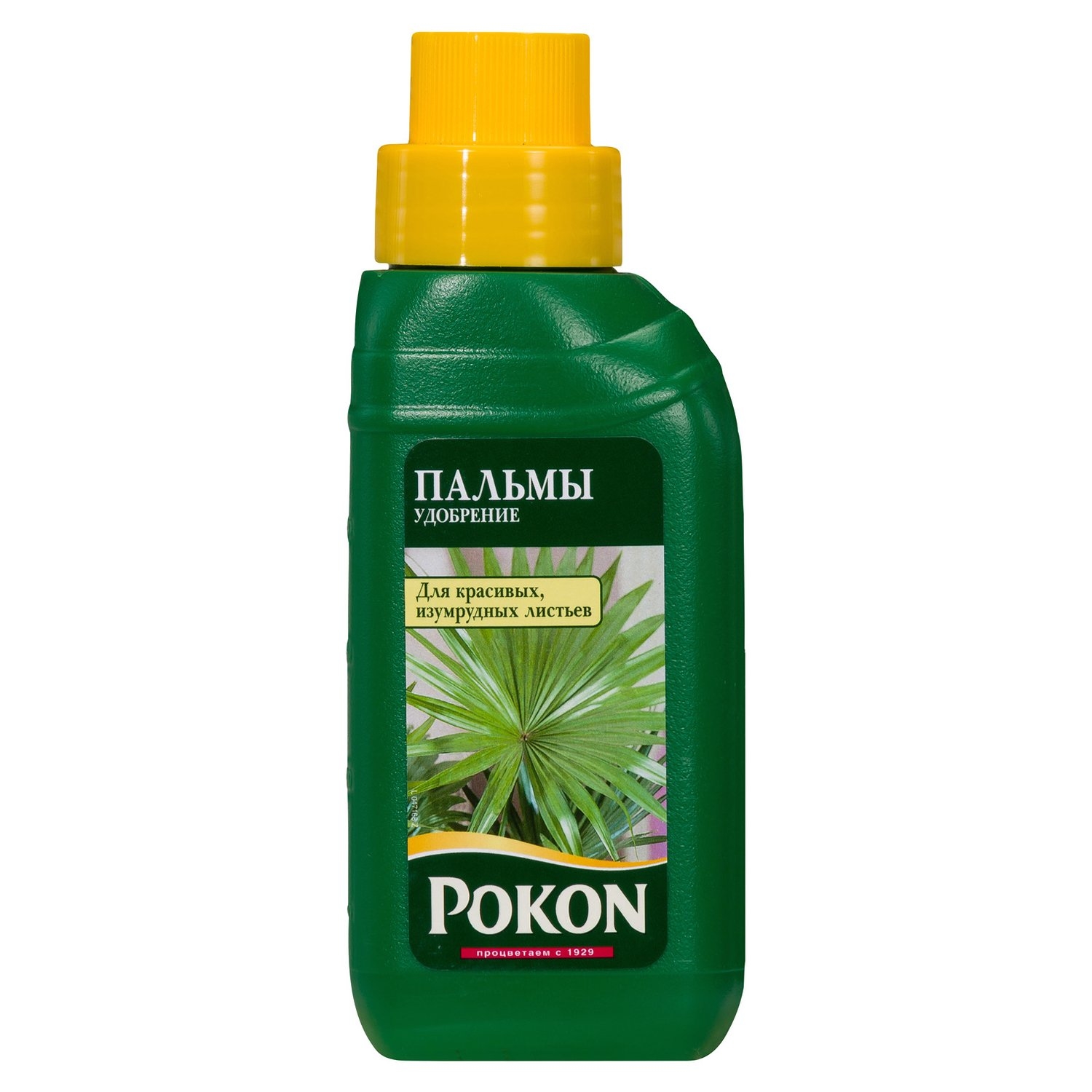
A mullein solution is suitable as an organic fertilizer.It is made with 1 part mullein and 20 parts water. Before applying top dressing, the soil must be moistened. Otherwise, a chemical burn of the roots will occur.
Transplanting is required only with gloves, since the plant is poisonous.
Diseases and pests
The main problem with cicas is rot. But sometimes pests affect this plant. Most often these are thrips.
Rot

Rot affects all parts of the plant. The roots turn black, soft and die. The leaves turn brown and wither, the "bump" becomes soft.
In this case, it is necessary to remove the flower from the pot, shake off the soil and rinse the roots under running warm water. With a sharp, clean knife, cut off the places affected by rot, grabbing 3-5 cm of a healthy root. Then dip them in a 2% solution of copper sulfate, Cuprozan or Bordeaux liquid. Sprinkle the sections with activated carbon powder and transplant the flower into a sterilized pot and soil. Once every 7 days for prophylaxis for 1.5-2 months, water the flower with a solution of Tsineb or Phtalan.
Subsequently, try not to over-water the cicas.
Shield
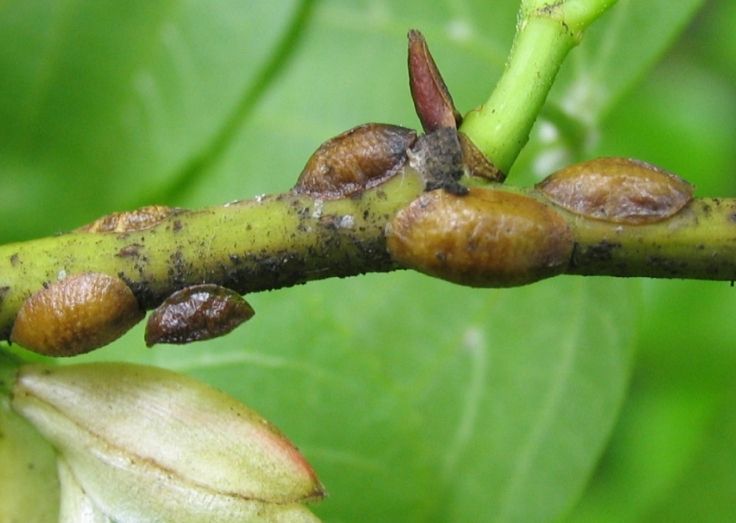
Brown plaques appear on the underside of the leaf. This is the scabbard shell, which feeds on the sap of the plant. To get rid of them, you need:
- Isolate cycas from other plants.
- Collect visible parasites.
- Wipe the leaves with alcohol.
- After 15-20 minutes, rinse the leaves under a warm shower, protecting the trunk and soil from water.
- Effective solutions are an infusion of garlic cloves or celandine (grind 50-60 g of raw materials and pour 1 liter of warm water). Spray plants with infusion.
- To obtain the result, you need to carry out 3 treatments every 7-10 days.
- If there is no effect, then use insecticides (Fitoverm, Confidor) according to the instructions.
Natural enemies of scale insects are good lighting and high air humidity.
Spider mite
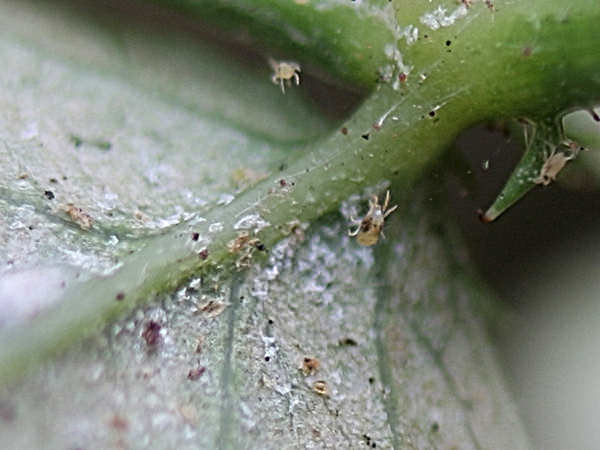
The spider mite enters houseplants with soil, things, or through open vents. As a result, small black punctures appear on the leaves. Through them, the tick sucks out the juice of the cicas. At the same time, the trunk and leaves are covered with a thin web. The leaves turn yellow and fall off.
Ticks cannot tolerate high humidity and bright light. Therefore, it is recommended to thoroughly spray the plant with water, put a bag on top and leave it for 2-3 days. Acaricides are effective against ticks (Aktellik, Aktofit, Neoron). Spray the leaves with a solution prepared according to the instructions or turn the pot over so that the leaves are in the container with the preparation. If it was not possible to destroy the tick the first time, then it is necessary to change the drug. You can also use an infusion of onions, wormwood, or citrus fruits.
Thrips
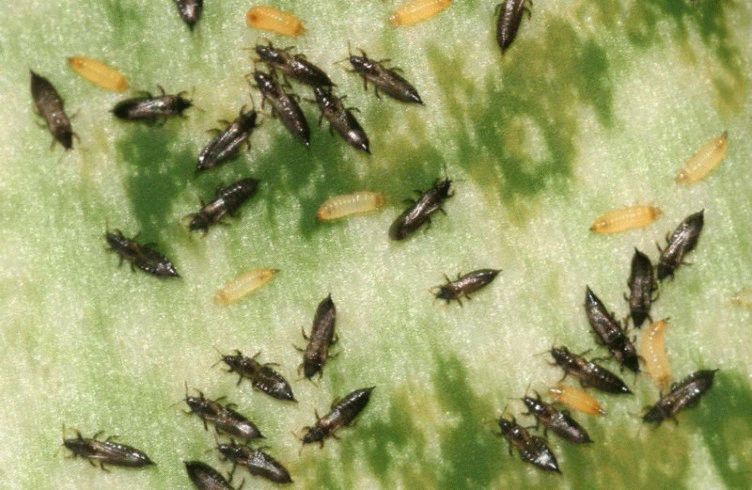
The development of thrips in the apartment is promoted by high temperatures and low air humidity. Pests colonize the lower part of the leaves, feed on sap and lay eggs. On the top of the sheet, you can find small light dots that grow rapidly.
Thrips love dry air, so it is recommended to spray the plant or turn on a humidifier. If pests are found, it is better to rearrange the flower away from other plants. Wipe the pot, tray and window sill with medical alcohol. From home remedies, an infusion of dandelion roots, tomato tops, and marigolds has proven itself well.
In case of severe damage, drugs such as Fitoverm, Agrovertin, Confidor are used. After processing, put on a bag on top and leave it for 24 hours. Repeat the procedure after 8-12 days.
Mealybug

The source of infection is a poor-quality substrate or a sick flower brought into the house. After the pest, small dirty white pellets, similar in appearance to cotton wool, remain on the leaves and roots, as well as sticky transparent secretions.
Mealybug does not like UV rays and high levels of humidity. As a preventive measure, you can buy a quartz lamp and irradiate the cicas from time to time. If pests are found, the leaves must be wiped with alcohol or soapy foam. After 15-20 minutes, rinse with a shower. With a small lesion, an infusion of tobacco leaves, garlic shoots are used.In case of severe damage, insecticides are used - Aktara, Biotlin, Iskra, Tanrek. A minimum of 3 sprays are required every 7-10 days.
Care errors and how to fix them
Due to improper care, the plant can feel bad.
Yellowed leaves
There are 3 reasons for this and ways to eliminate them:
- The direct rays of the sun fall on the cicas. You need to arrange a shadow or rearrange the flower to another place.
- Stagnant moisture. Adjust watering mode.
- Natural renewal. If only the leaves below turn yellow, then this is a natural process. This is how the foliage is renewed. You can remove yellowed leaves yourself.
Decay process
Rotting causes the death of the plant. But you can try to save it with the following method:
- Remove the flower from the pot and clean it from the soil.
- Cut off rotting areas.
- Dip the plant into the HOM solution.
- Dry and coat the cut areas with garden pitch.
- Treat the base with Kornevin.
- Plant in the sand.
No new leaves
In this case, the plant lacks light, heat and nutrients. It is necessary to correct the location of the flower and the feeding regime.
Young leaves are weak and long
The reason is the lack of light. Underdeveloped leaves must be removed and the pot moved to a brighter place.
Reproduction
It is problematic to reproduce a flower at home, since even in greenhouses the seeds do not always ripen. You can try 2 methods yourself.
Rooting offspring
Babies grow at the base of the trunk. To transplant, you need to wait until their diameter becomes 3 cm. Procedure:
- Clean the surface of the trunk of the main plant from the soil and cut off the "baby" with a sharp knife.
- Treat the cut with garden varnish or liquid paraffin, and for the main plant - with a 2% fungicide solution.
- Plant the "baby" in a pot of coarse sand, deepening it by 2/3.
- It is recommended to create conditions - lower heating, partial shade, temperature 27-30 degrees Celsius.
- The roots will appear after 6-12 months.
- After that, the plant can be transplanted into a mixture of sand, expanded clay, perlite and leaf humus.
When the first leaf appears, the flower is transplanted into ordinary soil.
Planting seeds
In most cases, the seeds quickly become unviable, so they must be germinated immediately after harvest. The maximum shelf life is only 6 months. Procedure:
- Before planting, the seeds should be soaked in warm water (27-32 degrees) for 5 days. Water needs to be changed every day.
- After 5 days, you should damage the skin with a nail file.
- Spread the seeds in containers with perlite or sand, slightly pressing them into the ground.
- Maintain temperature 25-27 ° C, humidity 65-75% and ambient light.
- Cover the container with glass or foil to create a greenhouse. Ventilate daily.
- The first shoots will be in 3-9 months.
- After 1-2 months, when the first leaf appears, transplant them into ordinary soil.
Taking care of a cicada at home is not easy, it is not always possible to cope with it even in greenhouses. But if successful, you can be proud of yourself.


